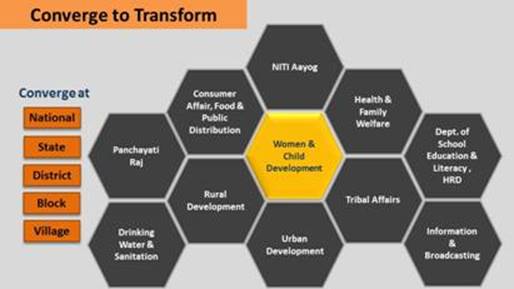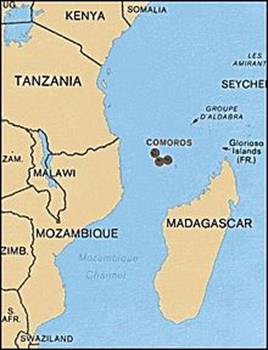



Menace of Malnutrition needs Humane Solution – SmritiZubinIrani
SOCIETY
Menace of Malnutrition needs Humane Solution – SmritiZubinIrani
Humane solution has to be developed to tackle the menace of malnutrition in India and for this the economic benefits of investing in nutrition has to be highlighted and propagated.
Minister's key arguments:
- Global Nutrition Report – 2018, which says that malnutrition costs India at least USD 10 billion annually in terms of lost productivity, illness and death and is seriously retarding improvements in human development and further reduction of childhood mortality.
- POSHAN is an exercise for life for all citizens and should not be limited to women and children.
- Ministry along with the Bill & Melinda Gates Foundation and Deendayal Research Institute is developing a POSHAN Atlas to map the crops and food grains grown in different regions of the country because the solution to tackling malnutrition lies in promoting regional cropping patterns and embracing local food that are rich in protein.
- NITIAayog needs to develop a framework to rank states on their achievement in the PoshanAbhiyan. It will help in rewarding ASHA workers.

PoshanAbhiyan :
- POSHAN Abhiyaan has been set up by Government of India on 18.12.2017 for a three-year time frame commencing from 2017-18 with an aim to reduce the level of stunting in children (0-6 years), under-nutrition (underweight prevalence)in children (0-6 years) and Low Birth Weight at 2% per annum and reduce anaemia among young children (6-59 months), women and adolescent girls at 3% per annum across the country.
- It ensures convergence with various programmes, organising Community Based Events; incentivising States/UTs for achieving goals.
- Community Mobilization and Awareness Advocacy leading to Jan Andolan – to educate the people on nutritional aspects.
- Under theAbhiyaan, all districts of the 36 States/UTs, including Tamil Nadu, have been covered for implementation in a phased manner.
- UNICEF provides technical support to MWCD for POSHAN Abhiyaan under Country Programme 2018-2022.
- Following components form the key pillar of this mission.
- ICDS-CAS(Common Application Software)
- Convergence
- Behavioural change,IEC Advocacy
- Training and Capacity building
- Innovations
- Incentives
- Grievance redressal
Source : PIB
Union HRD Minister launches a unique initiative for talented students ‘Pradhan Mantri Innovative Learning Programme- DHRUV
The new Programme ‘DHRUV ’will act as a platform to explore the talent of outshining and meritorious students, and help them achieve excellence in their specific areas of interest may it be science, performing arts, creative writing, etc.
About Pradhan Mantri Innovative Learning Programme:
- The Pradhan Mantri Innovative Learning Programme has been started to identify and encourage talented children to enrich their skills and knowledge.
- In centres of excellence across the country, gifted children will be mentored and nurtured by renowned experts in different areas, so that they can reach their full potential.
- It is expected that many of the students selected will reach the highest levels in their chosen fields and bring laurels to their community, State and Nation.
- With children drawn from all over the country, the DHRUV programme reflects the true spirit of EK Bharat Shrestha Bharat.
Method of the Programme:
- 60 outstandingly talented students have been selected in the first batch of DHRUV programme.
- To begin with, it will cover two areas i.e. Science and Performing Arts. There are 60 students in all, 30 from each area.
- The students have been broadly chosen from classes 9 to 12, from all schools including government and private.
- The science students will be divided into 3 groups of 10 each and also the performing arts students into 3 groups of 10 each.
- Each group from science stream will be required to produce a project under the mentorship of experts from the field of science.
- Each group in performing arts will be mentored by icons from the field of culture and will be required to choreograph a programme.
- All the six teams will be given themes relevant to issues being faced globally like environment change, pollution, terrorism, etc.
Source : The Pib
ENVIRONMENT
Mobile App, “mHariyali” Launched for ‘Environment Protection in Government Colonies’ Website
- The app is aimed to encourage public engagement in planting trees and other such Green drives.
- People can now upload information/photos of any plantation done by them, which is linked to app and will be displayed on the website www.epgc.gov.in.
- The App provides for automatic geo-tagging of plants.
- This app will also enable nodal officers to periodically monitor the plantation.
- It is launched by Ministry of Urban Affairs and Housing .
Source : The Pib
INTERNATIONAL
India and Comoros sign MoUs on Defence Cooperation, health, culture and arts
India and Comoros today signed 6 MoUs including one on defence cooperation.
- Other MoUs sought to cement cooperation in the fields of health and medicine, arts and culture and tele-education (e-VidyaBharati) and tele-medicine (e-ArogyaBharati).
- MoUs on exemption of Visa for Diplomatic and Official Passport holders for short visits and protocol on foreign office consultation were also signed.
- Comorian President conferred the ‘Order of the Green Crescent’, the highest civilian honour of the Union of Comoros, on the Vice President.
Other deals :
- India will be gifting medicines worth Medicines and medical equipments worth USD 1 million, USD 1 million for transport vehicles, USD 2 million for procurement of high-speed interceptor boats and 1000 MT of rice.
- He also announced Line-of-credit of USD 41.6 mn for setting up an 18MW power plant in Moroni and a vocational training centre.

Geography of Comros:
ART & CULTURE
Explained: How Mamallapuram became Mahabalipuram, regained old name
The venue of Prime Minister Narendra Modi’s meeting with China’s President Xi Jinping over Friday and Saturday has been referred to, interchangeably, Mamallapuram and Mahabalipuram.
Location of Mamallapuram:
- It is 56 km to the south of Chennai on the coast.
The Ministry of External Affairs’ media advisory mentions ‘Mahabalipuram’, and officials have been using that name in informal communication.
Origin of Name:
- It derives its name from Mamallan or ‘Great Wrestler’ — one of the names of Narasimhavarman I, the Pallava monarch who ruled from 630 AD to 668 AD, and who commissioned much of the architecture Mamallapuram is famous for.
BIRTH OF ‘MAHABALIPURAM:
- S.Swaminathan, author of Mamallapuram, a book on the architectural and sculptural achievements of the Pallavas, said Mamallapuram was the original name, even though the town is also called Mahabalipuram.
- The name Mahabalipuram emerged much later, some time in the Vijayanagara period (14th-17th centuries). But there is nothing to directly connect the Asura King Mahabali with Mamallapuram.
Back to Mammalapuram:
- Mamallapuramwas notified in a government gazette in 1957, and that name was reiterated when the ancient port town was declared a village panchayat in 1964.
- Instead of the association with a mythological king (Mahabali), the governments here made sure that the original name in the memory of a Tamil king was restored.
Reference : https://indianexpress.com/article/explained/how-mamallapuram-became-mahabalipuram-regained-old-name-6063275/
Explained: Going back 1300 years, the story of Mahabalipuram’s China connection
The setting speaks to several contemporary themes in India-China relations — and of contacts, both continuous and changing, across space and time. While the powerful symbolism of Mahabalipuram will likely not succeed in influencing China’s hard-nosed assertion over J&K and other issues with India, the remarkable historical significance of the venue bears underlining.
Chinese relations through Mahabalipuram :
- It was during Pallava king Narasingham I reign that Hiuen Tsang, the Chinese Buddhist monk-traveller, visited the Pallava capital at Kanchipuram.
- Narasimhavarman II (c.700-728 AD), also known as Rajasimhan, built on the work of earlier Pallava kings to consolidate maritime mercantile links with southeast Asia.
- Narasimhavarman II sent a mission to the Tang court in 720 with a request that would seem unusual in the context of India-China relations today.
- The emissaries of the Pallava king sought the permission of Emperor Xuangzong to fight back Arab and Tibetan intrusions in South Asia.
- Pleased with the Indian king’s offer to form a coalition against the Arabs and Tibetans, the Chinese emperor bestowed the title of ‘huaidejun’ (the Army that Cherishes Virtue) to Narayansimha II’s troops
- The Descent of the Ganga/Arjuna’s Penance, a rock carving commissioned by Narasimhavarman I, with its depiction of the Bhagirathi flowing from the Himalayas, may serve as a reminder of the geography of India-China relations, and their shared resources.
- In later centuries, the Coromandel coast retained its importance for trade between China and the west.
- In the 17th and 18th centuries, it was a staging post for the Dutch, French and British for control of the seas between South Asia and Southeast Asia, as the Europeans fought to protect their trade routes with China and other countries in the region.
- The ancient port city of Pondicherry, 80 km south of Mahabalipuram, was a French colony famous for its Chinese exports known as “Coromandel goods”, including crepe de chine.

© 2025 iasgyan. All right reserved